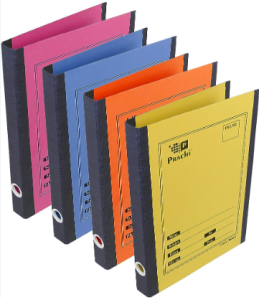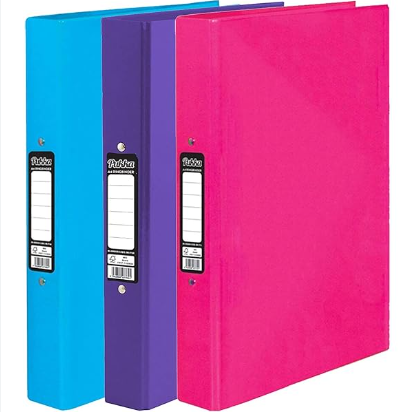Binders For Files
In the realm of organization and document management, binders stand as indispensable tools that have withstood the test of time. From classrooms to offices, binders play a pivotal role in keeping important papers, reports, and documents in an orderly and accessible manner. With a plethora of options available in the market, selecting the right binder for your specific needs can be a daunting task. This comprehensive guide aims to unravel the intricacies of choosing the best binders for files, considering factors such as material, size, ring type, and additional features.
Material Matters: Durability and Aesthetics
Binders are crafted from a variety of materials, each offering a unique blend of durability, aesthetics, and functionality. The most common materials include:
Vinyl: Vinyl binders are well-known for their durability and cost-effectiveness. They offer excellent protection against moisture and are available in an array of colors and styles. Vinyl binders are a popular choice for schools and offices due to their practicality and affordability.
Leather: Leather binders exude a sense of sophistication and elegance. They are favored in professional settings where a polished appearance is essential. Although they are more expensive than other materials, leather binders are known for their longevity and classic appeal.

Polypropylene: Polypropylene binders strike a balance between durability and flexibility. They are resistant to moisture and tearing, making them ideal for environments where documents are frequently accessed. These binders often have a sleek, modern appearance.
Fabric: Fabric-covered binders offer a unique texture and visual appeal. They are popular for personal projects or presentations. While not as rugged as other materials, fabric binders add a touch of creativity to your organization.
Size Matters: Standard vs. Specialty Sizes
Binders come in various sizes to accommodate different document formats. The two most common sizes are letter-size (8.5 x 11 inches) and legal-size (8.5 x 14 inches). However, there are also specialty sizes available to meet specific needs. For instance:
Half-Size Binders: These smaller binders are perfect for organizing smaller documents, such as invoices, receipts, or project notes.
A4 Binders: A4 binders are designed to fit the slightly larger European paper size (210 x 297 mm). They are suitable for international documents or those who prefer this size format.

Custom Sizes: Some manufacturers offer customization options, allowing you to create binders tailored to your precise requirements.
Ring Type: Choosing the Right Mechanism
The type of ring mechanism in a binder is a crucial consideration, as it affects how documents are inserted, removed, and organized. The most common ring types are:
Round Rings: These are the standard rings found in most binders. They are easy to open and close, making them suitable for frequently accessed documents. Round rings are available in various sizes, accommodating different document thicknesses.
D-Rings: D-shaped rings have a greater capacity than round rings. They hold more pages and allow documents to lie flat, preventing creasing. D-ring binders are often used for presentations, manuals, and larger projects.
Slant Rings: Slant rings are similar to D-rings but have a slightly slanted shape. This design enhances page visibility and makes turning pages smoother.
Additional Features: Beyond the Basics
Modern binders come equipped with various additional features that can enhance their usability and practicality:
Clear View Panels: Binders with clear overlay pockets on the front, back, and spine allow for easy customization. You can insert cover pages, labels, or spine inserts for quick identification.
Interior Pockets: Built-in pockets provide extra storage for loose papers, business cards, or CDs. This feature is especially handy for presentations and project files.
Locking Mechanisms: For confidential documents, consider binders with locking mechanisms to ensure privacy and security.
Spine Labels: Some binders have removable spine labels that can be replaced or customized, making it simple to locate specific binders on a shelf.
Budget Considerations and Brand Reputation
As with any purchase, budget plays a role in selecting the best binder for files. While premium materials and features may come at a higher cost, it’s important to find a balance between quality and affordability. Researching reputable brands with a history of producing reliable office supplies can guide you toward a binder that meets your expectations.
A Guide to Choosing the Best Binders for Files
Binders are essential tools for keeping files organized and easily accessible. Whether you’re a student, professional, or simply need to manage paperwork at home, selecting the right binder is crucial. This guide aims to help you make an informed decision by outlining key factors to consider when choosing the best binders for your files.
Binder Types:
Binders come in various types, such as ring binders, lever arch binders, and presentation binders. Consider the nature of your files and how frequently you need to access them. Ring binders are versatile and great for everyday use, while lever arch binders are better for larger documents, and presentation binders are ideal for showcasing documents.
Ring Size:
Rings are an important component of binders as they hold your documents in place. Common ring sizes include 1 inch, 1.5 inches, and 2 inches. Choose a ring size that accommodates the volume of your files. Avoid getting a binder with rings that are too large as it can lead to pages falling out.
Material and Durability:
Binders are often made from materials like vinyl, leather, or cardboard. Consider how often you’ll be using the binder and the environment it will be in. For frequent use, opt for a durable material like vinyl or leather. Cardboard binders are suitable for light use and shorter-term projects.
Capacity:
The capacity of a binder refers to how many pages it can hold. This is influenced by the ring size and the type of binder. Make sure the binder you choose can hold all your documents without getting overfilled, which can lead to difficulty in turning pages and potential damage.
Spine Width:
The spine width determines how much space you have to label and identify the contents of the binder. A wider spine allows for larger labels and easy identification on a shelf. If you have a lot of binders, consider uniform spine widths for a neat look.
Mechanism and Accessibility:
The binder’s opening and closing mechanism should be sturdy and easy to use. D-rings are known for allowing pages to lie flat, while round rings are more common and budget-friendly. Choose a mechanism that suits your preference and the usability you need.
Customization:
Some binders offer clear pockets on the front, back, and spine for inserting custom labels, covers, or title pages. This feature can be helpful for quick identification and personalization.
Budget:
Binders come in a wide price range. Set a budget that aligns with the quality and features you need. Investing in durable, high-quality binders can save you money in the long run by avoiding frequent replacements.
Brand and Reviews:
Research reputable binder brands and read reviews from other users. Feedback from customers can provide insights into the quality, durability, and overall satisfaction with a particular binder.
In conclusion
Binders for files are essential tools for organization and document management. The choice of material, size, ring type, and additional features should align with your specific needs and preferences. Whether you’re a student, a professional, or an organization, investing time in selecting the right binder will contribute to an efficient and well-organized workspace.
FAQs about the Best Binders for Files
What are the key features to look for when selecting the best binder for files?
When choosing a binder for files, consider factors such as the binder’s capacity (how many pages it can hold), ring type (D-ring or O-ring), material durability (vinyl, leather, etc.), and additional features like interior pockets, clear view covers, and spine labels. Assessing these features helps determine the binder’s suitability for your specific filing needs.
What is the advantage of D-ring binders over O-ring binders for filing documents?
D-ring binders have a distinct advantage in terms of page capacity and reduced page curl. The D-shaped rings allow pages to lie flat, preventing bending and curling, which is common with O-ring binders. This makes D-ring binders ideal for holding a larger number of documents while keeping them organized and neat.
Are there any recommended brands known for producing the best file binders?
Several brands are well-regarded for their quality file binders. Some popular options include Avery, Samsill, Wilson Jones, Case-It, and Staples. These brands offer a variety of binder types and sizes, catering to different preferences and organizational needs.
Can I use binders with archival quality materials for long-term document storage?
Yes, binders with archival quality materials, such as acid-free and lignin-free paper, as well as non-PVC materials, are suitable for long-term document storage. These materials help prevent documents from deteriorating over time and ensure that important files remain in good condition for years.
What binder size is most commonly used for standard office documents?
The most commonly used binder size for standard office documents is the letter size, which accommodates 8.5″ x 11″ paper. This size is prevalent in North America and is widely used for various business and organizational purposes. However, it’s important to choose a binder size based on the dimensions of the documents you plan to store to ensure a proper fit and functionality.
